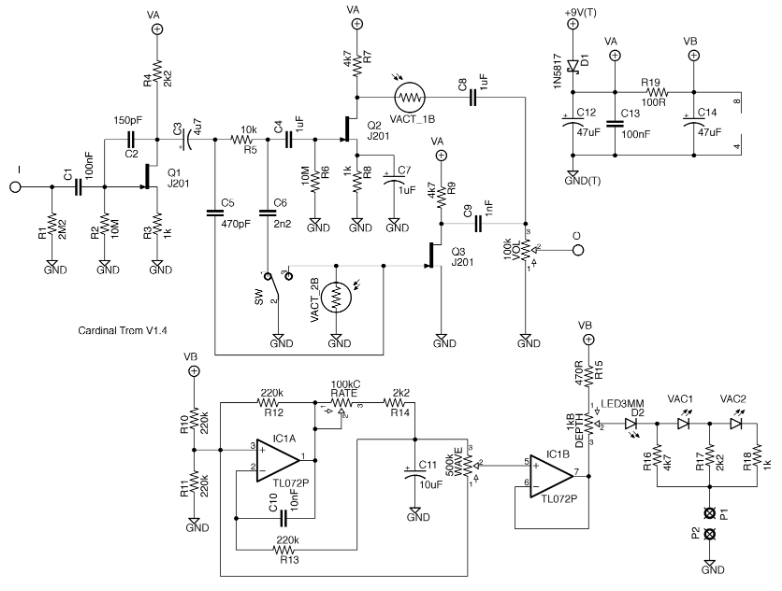Difference between revisions of "Cardinal Tremolo"
(→Phase Inversion: No) |
(→General Information) |
||
| Line 33: | Line 33: | ||
http://1776effects.com/wp-content/uploads/2015/03/Cardinal-Tremolo.pdf | http://1776effects.com/wp-content/uploads/2015/03/Cardinal-Tremolo.pdf | ||
| + | We currently only have Version 1 of the Cardinal Tremolo pcb. 1776 Effects has also released a Version 2. A quick look at both the schematics for v1 and v2 suggests that the only meaningful difference between the two is that the Version 2 board takes what are trimpots (set-em and forget-em) on the board and exposes them as full potentiometers. | ||
| − | + | From an examination of the schematic, it appears that the switch that toggles between the harmonic tremolo and the standard tremolo does so by either including or excluding the second vactrol. | |
==Pedal Manual== | ==Pedal Manual== | ||
Revision as of 15:38, 25 April 2018
The Cardinal Tremolo v1 is a tremolo effect evocative of the harmonic tremolo effect that was available from certain Fender amps, from 1960 to 1963. These amps include:
- The Fender Concert,
- The Fender Pro,
- The Fender Showman,
- The Fender Super, and
- The Fender Twin
Thermionic Studios has purchased this PCB and sourced the parts necessary to build this pedal. We are in the process of building the pedal and will have more to report upon completion.
Per the build notes document, this is a circuit by Jon Patton and was extensively influenced by previous tremolo pedal designs. In the build notes, Jon credits:
This circuit is based in part on RG Keen's Pro-Vibrato schematic. The LFO was adapted from CultureJam's Shoot the Moon Tremolo, which in turn adapted from Dann Green's Tremulus Lune. Thanks to Jimi Photon for the inspiration and samhay, ~arph, and duck_arse for discussions and suggestions on DIYStompboxes.
Controls
- Knob 1 - "Depth": Sets the depth of the volume swell of the tremolo. Clockwise turning increases the depth of the swell.
- Knob 2 - "Rate": Sets the speed of the swell of the tremolo. Clockwise turning increases the rapidity of the period of the swell.
- Switch 1 - "Select": Allows selection between Harmonic and Standard Tremolo functions.
Bypass:True
The Cardinal Tremolo is a true bypass pedal.
General Information
The Cardinal Tremolo makes available both the amplike "Harmonic" tremolo, as well as a standard volume-swell tremolo effect.
http://1776effects.com/wp-content/uploads/2015/03/Cardinal-Tremolo.pdf
We currently only have Version 1 of the Cardinal Tremolo pcb. 1776 Effects has also released a Version 2. A quick look at both the schematics for v1 and v2 suggests that the only meaningful difference between the two is that the Version 2 board takes what are trimpots (set-em and forget-em) on the board and exposes them as full potentiometers.
From an examination of the schematic, it appears that the switch that toggles between the harmonic tremolo and the standard tremolo does so by either including or excluding the second vactrol.
Pedal Manual
As of this time, 1776effects.com has not issued a separate manual on how to use the pedal. The best current references that we're aware of are this wiki page, or the build manual linked here to the 1776 Effects website which describes the architecture of, and how to build the pedal.
Phase Inversion: No
From our examination of the schematic below, the Cardinal Tremolo, v1 appears to not invert phase on the output as compared with the signal that goes into the pedal.
| Schematic ID | Electronic Part | Action | Phase State |
|---|---|---|---|
| Q1 | J201 | Inverts | Inverted |
| Q2* | J201 | Inverts | Reverted - see note 1 |
| Q3 | J201 | Inverts | Reverted |
| IC1a* | TL072 | Does not Invert | Unaffected - see note 2 |
| IC1b | TL072 | Does not Invert | Unaffected |
- NOTE 1: The signal is split after passing through Q1 going through both Q2 and Q3. However, signal that goes through Q2 does not go through Q3. Similarly, signal that goes through Q3 does not go through Q2. Both Q2 and Q3 invert phase, so that when the signals combine again after having passed through Q2 or Q3, they still have the same phase. Phase is inverted at Q1, and then reverted at either Q2 or Q3 back to the original phase.
- NOTE 2: IC1 doesn't appear to invert the sound signal phase through either portion of the integrated circuit. IC1 is used to modify how the speed and depth controls affect the sound signal, but the current going through IC1 never touches the audio signal.
As with all schematic observations, this will need to be born out by testing of the actual pedal.
Schematic
Artists
We are currently unaware of any artists actively using the pedal now, or who have in the past.
- Additional Sources
